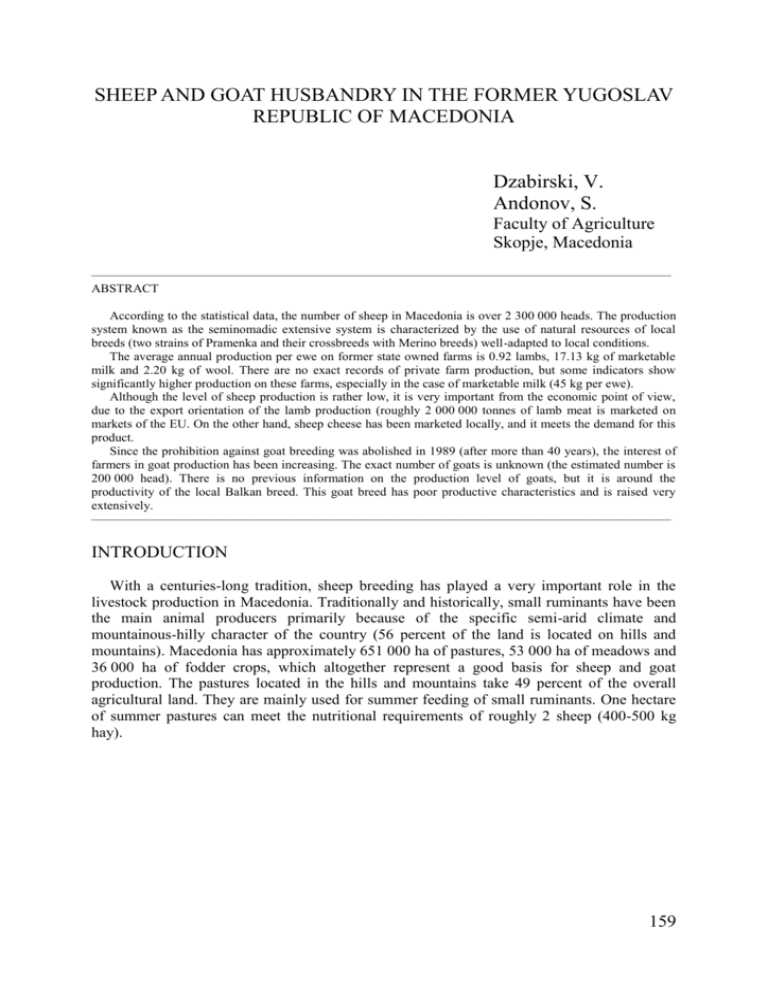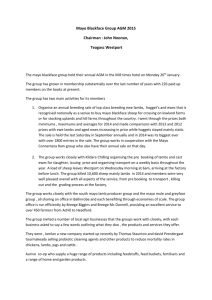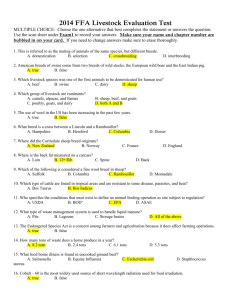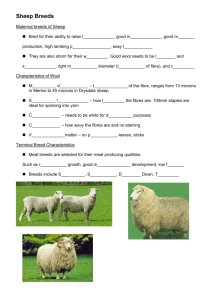sheep and goat husbandry in the former yugoslav republic of
advertisement

SHEEP AND GOAT HUSBANDRY IN THE FORMER YUGOSLAV REPUBLIC OF MACEDONIA Dzabirski, V. Andonov, S. Faculty of Agriculture Skopje, Macedonia ————————————————————————————————————————————— ABSTRACT According to the statistical data, the number of sheep in Macedonia is over 2 300 000 heads. The production system known as the seminomadic extensive system is characterized by the use of natural resources of local breeds (two strains of Pramenka and their crossbreeds with Merino breeds) well-adapted to local conditions. The average annual production per ewe on former state owned farms is 0.92 lambs, 17.13 kg of marketable milk and 2.20 kg of wool. There are no exact records of private farm production, but some indicators show significantly higher production on these farms, especially in the case of marketable milk (45 kg per ewe). Although the level of sheep production is rather low, it is very important from the economic point of view, due to the export orientation of the lamb production (roughly 2 000 000 tonnes of lamb meat is marketed on markets of the EU. On the other hand, sheep cheese has been marketed locally, and it meets the demand for this product. Since the prohibition against goat breeding was abolished in 1989 (after more than 40 years), the interest of farmers in goat production has been increasing. The exact number of goats is unknown (the estimated number is 200 000 head). There is no previous information on the production level of goats, but it is around the productivity of the local Balkan breed. This goat breed has poor productive characteristics and is raised very extensively. ————————————————————————————————————————————— INTRODUCTION With a centuries-long tradition, sheep breeding has played a very important role in the livestock production in Macedonia. Traditionally and historically, small ruminants have been the main animal producers primarily because of the specific semi-arid climate and mountainous-hilly character of the country (56 percent of the land is located on hills and mountains). Macedonia has approximately 651 000 ha of pastures, 53 000 ha of meadows and 36 000 ha of fodder crops, which altogether represent a good basis for sheep and goat production. The pastures located in the hills and mountains take 49 percent of the overall agricultural land. They are mainly used for summer feeding of small ruminants. One hectare of summer pastures can meet the nutritional requirements of roughly 2 sheep (400-500 kg hay). 159 CURRENT SITUATION IN SHEEP PRODUCTION Number of sheep and structure of production According to official statistical data (Statistical YearBook of Macedonia) the total number of sheep in Macedonia is about 2 300 000 heads (1 600 000 ewes). However, some recent information published in the annex to the 1996 statistical year book, indicate a decrease in the overall sheep population by 25 percent, i.e. 1 810 000 sheep (1 230 000 ewes). The exact number of sheep farms is unknown, especially small private farms, because during the period of transition only the large former state farms, with 1000 – 25 000 heads were known (around 70). Their share in the total sheep population was almost 10 percent. It is obvious that sheep production in Macedonia has been based on small private farms with flock sizes between 50 and 150 ewes, but seldom up to 300 ewes. These farms have been managed and maintained as a family business, using family land, housing (barn) facilities and labour. The size of the farms is very dependent on the size of the property, knowing that 46 percent of the households own an average of 0.51 ha of land, 34.6 percent own 1.96 ha, 11.2 percent own 3-5 ha and households with more than 5 ha account for 8.1 percent. Larger farms or a group of farmers from one village rent state pastures during the summer period. Breeding Structure and Technology of Production The breeding structure of the sheep population in Macedonia consists of two varieties of the Pramenka breed (Zackel, Tzurcana), Ovcepolian (60 percent) and Sarplanian (30 percent) and their crossbreeds with various Merino breeds. The productivity of cross breeds is close to the native population of the Balkan Peninsula. Trait Live weight Milk yield Fertility Birth live weight Live weight of lambs at 90 days Wool yield Performance 32 – 35 kg 70 – 90 l 100 – 110 percent 2 – 4 kg 15 – 18 kg 1.5 kg During the early 1980s the government established a closed nucleus farm of 1 000 ewes of Merinolandshaf, with the goal to improve the lamb production. Nowadays, the farm is producing pure and F1 cross breed rams to meet the demand for improved rams for private farmers. Cross breed lambs are characterized with better fattening performance and faster development, up to 15 kg as compared with local breed lambs. The management system is considered semi-nomadic extensive. From the middle of May to the beginning of November, sheep are located in the mountainous pastures. In the other half of the year, flocks are moved into valleys, to so-called winter pastures. The production technology is traditional, fully adapted to the natural resources and biological behavior of sheep. The lambing occurs in January to February, lambs are weaned until March or April and ewes are milked until mid-July. Multiple purpose sheep production, i.e. meat, milk and wool, is still very accepted by farmers. The average annual production per ewe in the former state- 160 owned farms was 0.92 lambs, 17.31 kg of marketable milk and 2.2 kg of wool. However, there is an estimate that private farmers have rather higher production, particularly in milk yield, which is close to 45 kg of marketable milk. The official figure is 43 kg of milk yield per ewe. Nevertheless, such a production has small economic potential, but it results in a financial stability to the farmers during the transition period of the country. In the regions where the sheep population is based on Merinolandshaf cross breeds, the management system in reference to lamb production, is advanced. Farmers practice off-season breeding, by treating their ewes pharmacologically (P+PMSG). Sheep feed and nutritional regimens are closely related to the opportunities of the farmers for forage production, as well as their financial capacity for partial grain supply (barley and feed meals for lambs). In most cases, ewes are fed under the requirements, particularly during the winter, when the requirements are the highest (late pregnancy and first stage of lactation). The annual energy requirements are partly met by pasture grazing, but half of it should be provided by feeding the animals on farms. Market for Sheep Products The lamb meat production is targeted mainly to the Italian market in two seasons, i.e. for the Easter and Christmas holidays. The lambs marketed for Christmas achieve a 30 percent higher price than those for the Easter holiday season. This market is traditionally looking for carcass weight of 7-8 kg, hence the lambs are slaughtered with 15 kg live weight in licensed and EU registered slaughterhouses in the country. In the last few years, some disturbance in the Macedonian lamb exports has occurred due to specific political circumstances and an epidemiological situation in the Macedonian livestock production sector. Consequently, there is an embargo to meat exports from Macedonia into the countries of the EU, and it is expected to be effective until the end of 1997. The importance of the Italian market for sheep production in Macedonia is illustrated by the fact that the volume and value of this export is 2 000 tonnes of meat or US$10 000 000, on the average. In the past this export used to be worth US$30 000 000. According to the latest statistical data, the annual production of sheep milk in Macedonia is 53 000 000 litres. However, the significant part of the income to the farmer (due to the embargo nowadays it accounts for 70 percent of the total income) is sheep milk, marketed as white cheese on the local markets. The current price of this cheese is between DM6.5 and 9 per kg, depending on its quality and regional origin. The wool market is very difficult due to the low price of sheep wool. Therefore it is used for carpet production or wooden hand-made ornaments. Policy and Government Support to the Sheep Industry Associations of private farmers have been recently initiated and established throughout the country, influenced by The World Bank Project for private farmers support as well as by the farmers interest in organized lamb marketing. The Word Bank Project is being implemented by the Extension Service, which operates on a regional basis countrywide, and is financed by the Ministry of Agriculture, Forestry and Water Economy of Macedonia. In addition, transformation and modernization of the Extension Service is influenced and facilitated by the same World Bank programme. The government support to sheep farmers consists of an Annual Programme for promotion of agricultural production. Specifically, for the sheep and goat industries in 1997, the amount of 6 400 000 denars (DM 200 000) of the Macedonian budget was allocated to be used for the following activities: 161 Subsidized supply of rams of Merinolandshaf breed; Subsidized purchase of imported ewes and rams of the Awassi and Chios breeds; Subsidized purchase of imported goats (does and bucks) of the Saanen and Alpine breeds; Induction and synchronization of oestrus and AI. One of the most important Programmes, supported by The World Bank is ear tagging and identification of the livestock in Macedonia. This project has several objectives such as follows: disease prevention and health protection of the livestock population; control of livestock movement; to establish the basis for an identification system for the purpose of genetic selection. This project is expected to establish the foundations for acquisition of insight into the realistic population size, selection scheme applications, control of infectious and parasitic diseases, etc. The implementation of this project will contribute to the solution of problems with exports to the EU countries. PRESENT SITUATION IN THE GOAT INDUSTRY The administrative prohibition of goat breeding in the territory of Macedonia in 1947 resulted in disasterous consequences to this production. During the period of the goat prohibition, which lasted for more than forty years, the goats in the entire territory of the former Socialist Republic of Macedonia were slaughtered. As a result, the number of goats was rapidly reduced from 516 800 in 1947 to 47 000 in 1949, or more than 90 percent. However, 42 years later, goat production was again allowed (in 1989). Since then, the interest of the farmers in goat production has been increasing. But in spite of the ban on goats, a small population of goats could be found, mainly kept together with sheep and registered as sheep. The present situation has not been seriously studied yet so that the exact number of goats is unknown. However, according to some estimates it is expected to be around 200 000 animals. The local goat population in Macedonia belongs to a Balkan goat breed. Also, there is evidence of existence of cross breeds between the local population and Saanen breed, which had been imported between the two World Wars. Nevertheless, the production of goats is quite variable because of the different conditions of production. The production characteristics of the present goat population are: live-weight 30-40 kg, litter size 1.5, milk production 90-110 litres (for 7 months lactation) and hair production 0.5 kg. The management system is completely related to the season. The does are mated at the end of September and kidding occurs from February to March. The birth-weight of the kids is around 2-2.5 kg and the body weight at 30 days is 7 kg. The kids are sold on the local markets at the same price as lambs DEM 2.5-3.0 /kg, with between 10 and 15 kg live-weight. Most of the milk is sold to the cheese plants, but there is an increasing tendency for cheese production at a the farm level. Moreover, a proper market for goat products has not been established yet, even though there is a certain demand from export markets for standardized types of goat cheeses. The access of new markets for goat dairy products as a dietary and organic food is a very important aspect for reactivating goat production and the processing of goat products in Macedonia. 162









![Teeswater Sheep Breeders` Association Me[...]](http://s3.studylib.net/store/data/007144755_1-44ce9acb9fb5e8e8a9fd22b9cf356606-300x300.png)